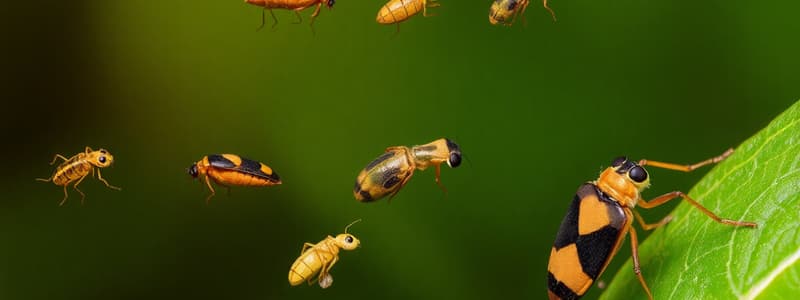Podcast
Questions and Answers
What is a unique characteristic of the young frog compared to the adult frog?
What is a unique characteristic of the young frog compared to the adult frog?
- The young frog is exclusively aquatic. (correct)
- The young frog has fully developed wings.
- The young frog lives both in water and on land.
- The young frog resembles the adult frog.
Which animal has a life cycle that takes place entirely on land?
Which animal has a life cycle that takes place entirely on land?
- Butterfly
- Chicken (correct)
- Frog
- Mosquito
What stage is not present in the life cycle of a cockroach?
What stage is not present in the life cycle of a cockroach?
- Pupa Stage (correct)
- Chick Stage
- Adult Stage
- Nymph Stage
How do larva and pupa of a mosquito breathe underwater?
How do larva and pupa of a mosquito breathe underwater?
What happens during the nymph stage of a grasshopper?
What happens during the nymph stage of a grasshopper?
What is an important role of adult butterflies in the ecosystem?
What is an important role of adult butterflies in the ecosystem?
Which characteristic is shared by both the young of a cockroach and a grasshopper?
Which characteristic is shared by both the young of a cockroach and a grasshopper?
What is a disadvantage of the life cycle of a mosquito?
What is a disadvantage of the life cycle of a mosquito?
What key feature distinguishes the larval stage from the pupa stage in animal life cycles?
What key feature distinguishes the larval stage from the pupa stage in animal life cycles?
How does the nymph stage differ from the larval stage?
How does the nymph stage differ from the larval stage?
What is a primary function of the pupal stage in an animal's life cycle?
What is a primary function of the pupal stage in an animal's life cycle?
Why is it beneficial for organisms X and Y to lay many eggs?
Why is it beneficial for organisms X and Y to lay many eggs?
What is a common characteristic of the larva in an animal's life cycle?
What is a common characteristic of the larva in an animal's life cycle?
Flashcards
Larva characteristics
Larva characteristics
Larva doesn't look like the adult, eats a lot, and molts multiple times before becoming a pupa.
Pupa characteristics
Pupa characteristics
Pupa doesn't resemble the adult, doesn't eat or move, and develops adult form internally.
Nymph characteristics
Nymph characteristics
Nymph resembles the adult but is smaller and wingless, molting multiple times before becoming an adult.
Organism X's nymph to adult
Organism X's nymph to adult
Signup and view all the flashcards
Importance of laying many eggs
Importance of laying many eggs
Signup and view all the flashcards
Frog's 3-stage life cycle
Frog's 3-stage life cycle
Signup and view all the flashcards
Chicken life cycle
Chicken life cycle
Signup and view all the flashcards
Cockroach life cycle
Cockroach life cycle
Signup and view all the flashcards
Butterfly life cycle
Butterfly life cycle
Signup and view all the flashcards
Mealworm beetle life cycle stages
Mealworm beetle life cycle stages
Signup and view all the flashcards
Mosquito 4-stage life cycle
Mosquito 4-stage life cycle
Signup and view all the flashcards
3-stage life cycle characteristics
3-stage life cycle characteristics
Signup and view all the flashcards
4-stage life cycle
4-stage life cycle
Signup and view all the flashcards




